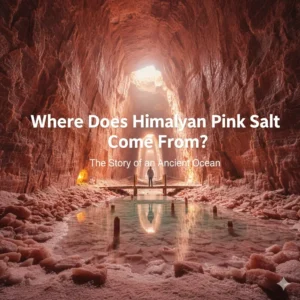Himalayan pink salt is a naturally occurring mineral formed from ancient seabeds buried deep beneath the Himalayas. Beyond its distinctive color and culinary appeal, it represents a preserved chapter of Earth’s geological evolution. For industry professionals, understanding its authentic origin—the Khewra Salt Mine in Pakistan—adds both sourcing credibility and storytelling depth. This article examines its formation, extraction, and journey from geological deposit to global ingredient.

Prerequisites: Tools & Knowledge Needed
Investigating the origins of Himalayan Pink Salt benefits from a foundation in both earth science and cultural history. A clear understanding of Earth’s geological evolution links the salt’s formation to ancient seabeds within Pakistan’s Khewra Salt Mine. Familiarity with traditional mining methods and historical trade practices enhances appreciation for how this natural resource has shaped regional and global heritage.
- Fundamental knowledge of geology and prehistoric Earth development.
- Understanding of salt mining techniques and terminology.
- Interest in the cultural and historical context of natural resources.
- Access to reliable references on the Khewra Salt Mine and the Himalayan salt industry.
Step-by-Step Guide to Tracing Himalayan Pink Salt Origins
Step 1: Examine the Formation of Ancient Seas
Before the Himalayas emerged, a vast ocean once covered what is now northern Pakistan. About six hundred million years ago, prolonged evaporation of this inland sea left behind thick salt deposits composed mainly of halite. Over time, these mineral layers solidified and became deeply buried beneath the Earth’s surface.
As tectonic movements uplifted the region, these salt beds rose into the Salt Range mountains. Each pink crystal found today is evidence of that transformation—an enduring trace of an ocean that existed long before human history.
Step 2: Trace the History of the Khewra Salt Mine
Located in Pakistan’s Punjab region, the Khewra Salt Mine is the second largest of its kind worldwide. Historical accounts attribute its early discovery to local communities, with organized extraction taking shape during the Mughal era.
By the late nineteenth century, structured tunnels and chambers were established, improving safety and output. Today, the Khewra mine continues to operate efficiently, serving as both a vital industrial source and a symbol of Pakistan’s geological and cultural heritage.
Step 3: Explore Traditional Mining Methods
Extraction at Khewra still follows precise manual methods that prioritize structural integrity and product purity. Miners employ the “room and pillar” system, carving chambers while leaving supporting pillars of salt to stabilize the mine.
This method minimizes contamination from heavy machinery and preserves the natural character of the salt. Each block is carefully separated and finished by hand, maintaining the texture and mineral composition that distinguish Himalayan salt in both culinary and decorative applications.
Step 4: Understand the Source of the Pink Hue
Himalayan salt’s distinctive pink coloration results from trace minerals—primarily iron oxide—naturally embedded in its crystalline structure. These inclusions create a spectrum of hues ranging from pale rose to deep orange, depending on mineral concentration.
Unlike artificially colored salts, these variations occur naturally and visually reflect the unique mineral diversity shaped by ancient geological processes over hundreds of millions of years.
Wholesale Himalayan Salt Blocks for Culinary & Hospitality
Source authentic Himalayan salt blocks made from Jurassic-era mineral formations. Partner with Jilin Ever Creation for FDA- and EU-certified pink Himalayan salt extracted from Pakistan’s Khewra Salt Mine. Customize dimensions, textures, and packaging to enhance dining, retail, or hospitality experiences with salt blocks engineered for grilling, chilling, and serving.

From Local Commodity to Global Phenomenon
Himalayan pink salt originated as a local resource in Pakistan’s Salt Range, extracted from the Khewra Salt Mine within the Pothohar Plateau. For centuries, nearby communities used it for preserving food and regional trade, valuing its mineral richness and natural purity. Over time, its distinct pink hue and geological heritage began attracting broader attention beyond the local markets.
During the Mughal period, established trade routes carried Himalayan salt across South Asia, transforming it into a sought-after commodity. The British introduction of industrial mining in the nineteenth century further formalized production, integrating Himalayan salt into the global market as a traceable, export-grade resource.
Today, Himalayan pink salt is valued worldwide—not only as a culinary ingredient but as a feature in wellness and interior design. Its evolution from ancient mineral deposit to international product illustrates how natural materials can bridge history, culture, and modern consumer interest.
Geological Features of the Salt Range and Pothohar Plateau
The Salt Range and Pothohar Plateau in Pakistan present a remarkable geological landscape forged by the collision of the Indian and Eurasian tectonic plates. This region forms part of a fold-and-thrust belt system, where sedimentary rocks—once part of an ancient seabed—were compressed, uplifted, and exposed over millions of years. These formations reveal one of the most complete sequences of Precambrian strata on Earth, enriched with extensive salt and mineral deposits.
Within these layers, thick beds of halite alternate with gypsum, shale, and limestone. The deposits date back roughly six hundred million years, when the evaporation of shallow seas left behind vast, mineral-rich sediments. Subsequent burial and geological pressure transformed these sediments into crystalline formations that display the distinctive pink and orange hues characteristic of Himalayan salt.
Stable tectonic conditions and an arid climate preserved these salt reserves through significant environmental changes. From prehistory to the present, the Khewra Salt Mine continues to expose this ancient geological record, offering scientists and historians alike a preserved view into Earth’s distant marine past beneath Pakistan’s rugged mountains.
Chemical Composition and Health Aspects of Himalayan Pink Salt
Himalayan Pink Salt consists primarily of sodium chloride, much like common table salt, but it also includes trace amounts of iron, magnesium, potassium, and calcium. These minerals contribute to its distinctive pink tone and are often cited in discussions of its potential health value. Naturally crystallized in the Khewra region of Pakistan from an ancient seabed, the salt preserves its mineral signature from hundreds of millions of years ago.
Although widely marketed for benefits such as mineral balance, air purification, and improved hydration, scientific evidence shows that the trace minerals occur in extremely small quantities—too minor to deliver meaningful nutritional or therapeutic effects. Claims of detoxification or ionizing properties remain unverified in controlled studies.
In culinary use, Himalayan salt functions the same as sea or refined table salt: it enhances flavor and supplies essential sodium for bodily processes. Its primary distinctions lie in color, texture, and geological origin rather than measurable health advantages. Moderation remains essential to maintain overall well-being, no matter which salt variety is chosen.
Frequently Asked Questions About the Origin of Himalayan Pink Salt
Is all pink salt sourced from the Himalayas?
No. Authentic Himalayan Pink Salt comes exclusively from the Khewra Salt Mine in Pakistan’s Salt Range. Other pink salts found in regions such as Australia or Peru differ in mineral makeup and geological origin.
How is Himalayan salt extracted?
Miners at the Khewra Salt Mine use a traditional “room and pillar” method, cutting and chiseling salt by hand within large underground chambers. The extracted blocks are then cleaned, sorted, and shaped for culinary, decorative, and therapeutic applications—without chemical refining.
What gives Himalayan salt its pink hue?
The color results from trace minerals—primarily iron oxide—naturally incorporated into the salt crystals. These minerals create subtle variations in tone, ranging from soft rose to deep orange, depending on concentration levels.
Is Himalayan salt healthier than sea salt?
Both are primarily composed of sodium chloride. Himalayan Pink Salt contains trace amounts of minerals like calcium, magnesium, and potassium, which add mild flavor complexity but do not significantly change its nutritional profile. Health outcomes depend more on overall sodium intake than on salt type.
How old is Himalayan Pink Salt?
Himalayan Pink Salt formed over 600 million years ago from ancient seabeds that evaporated during the Precambrian era. Each crystal preserves a fragment of Earth’s deep geological history.
Final Thoughts
Himalayan pink salt embodies the story of an ancient ocean sealed within the Earth for hundreds of millions of years. Each crystal formed as seawater evaporated, leaving mineral-rich layers that would eventually reemerge as part of modern culinary and wellness traditions.
Today, the Khewra Salt Mine in Pakistan sustains this natural legacy. It serves as a living intersection between geology’s slow transformation and humanity’s enduring exploration of Earth’s origins.
Using Himalayan salt is to engage with a material shaped by immense geological time—a tangible reminder of the planet’s ancient, evolving history.






